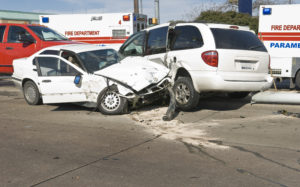Company Driver or Courier?
Two “events” occurred nearly simultaneously. First, I had my knee replaced – keeping me mostly unavailable for a few months. When I returned I learned that a client was under pressure by new management to reduce his operational costs. They purchased three vehicles and currently trying to hire company drivers, in other words, bringing the courier service inside the company. After feeling very guilty for being out of reach for so long, came the realization that these two seemingly different events were very much the same. Just like when my cane took weight and stress off my knee pre-surgery, he had, prior to coming to us ten years ago, used internal employees to complete the daily route. Everything seemed great. One day I fell and one day one of his employees had an accident. Here are the facts to know before you let an employee go to the bank vs. having a courier company – with professional drivers.
TrafficSafety.org provides these facts:
10 FACTS EMPLOYERS MUST KNOW BEFORE THEY LET AN EMPLOYEE OUT THE DOOR TO RUN AN ERRAND
For any organization with employees on the roadway
- In 2005, 43,443 people were killed and 2,699,000 were injured in 6,159,000 police-reported motor vehicle crashes. Daily that represents 17,000 reported crashes and 119 deaths.
- Motor vehicle crashes are the leading cause of death for all age groups from 3 to 33 years of age. Crashes are the 3rd leading cause of years of potential life lost for all ages combined.
- Motor vehicle crashes are the leading cause of occupational fatalities in the U.S.
- A typical driver in the U.S. travels 12,000 to 15,000 miles annually and has a one in 15 chance of being involved in a motor vehicle collision each year. With most fleet drivers traveling 20,000 to 25,000 miles or more each year, they have a greater crash exposure.
- The most dangerous part of the day for any employee is the time they spend in their vehicle with a crash occurring every 5 seconds, property damage occurring every 7 seconds, an injury occurring every 10 seconds, and a motor vehicle fatality occurring every 12 minutes.
- Forty-one percent of the average vehicle miles traveled per household are from commuting to and from work (27%) and driving on work-related business (14%).
- In 2000, the economic cost of crashes to employers was $60 billion resulting in 3 million lost workdays. Two thirds of the cost ($40 billion) was from on-the-job crashes while one-third ($20 billion) was from off-the-job crashes for employees and their benefit-eligible dependents.
- The average on the job crash costs an employer about $16,500 or just under $0.16 per mile driven. Crashes involving injuries cost substantially more — $504,408 for a fatal injury and $73,750 for a nonfatal injury.
http://www.htsa.gov/people/injury/airbags/economicburden/pages/WhatDoTCCost.html breaks it down even further and State by State.
Savings vs. Accident Risk
So I had my operation, completely delighted with my new knee, and frankly, my client was delighted to not have the employee as driver burden. Since that time his company has changed ownership 3 times. They want company drivers. The new organization is going to save $102.00 per week.
One accident will cost them the 161 weeks work of savings (that is without an injury)!
Over the years many companies have come to us after an employee was in an accident while picking up the mail from the Post Office. The constant damage to the vehicles was at the point of not worth repairing them any longer, loss of productive working hours of employee, etc. Results of accidents vary, death being the worst.
How does this affect your workplace? Are you gambling with employees by having them run company errands? The client’s new management sure is. Two if the drivers will be driving long distances on mountain roads every day.

An ounce of prevention is worth a pound of cure.
Ancient proverb
So, 5 reasons to use a courier…
1. Courier companies have insurance to cover accidents, and the resources to replace drivers when something does happen (illness, emergency and more). Drivers have safety classes and are carefully screened.
2. Your company is protected from a variety of claims: from insurance fraud to wrongful death.
3. Fuel is the number 1 cost – so the higher the MPG figures our vehicles achieve, the less fuel we have to buy resulting in environmental benefits. This is done by matching the load to the vehicle – you don’t use a transit van to deliver a confidential folder that can far more efficiently be delivered on a motorcycle or scooter. Regular maintenance to help vehicles burn fuel optimally and updating of the fleet – we have recently started using an LPG powered van which produces 33% less CO2. We use van substitutes as often as possible (Kia Soul and Nissan Cubes).
4. The quicker we get from our departure point to our destination, the more work we can achieve from the vehicle in a day – but this is not achieved by a the vehicles driving faster as this is less fuel efficient and more dangerous for other road users and pedestrians, it is achieved by accurate routing, avoiding congestion which is the number one enemy of the courier driver – this is made possible by using the latest navigation equipment that is able to update traffic information every two minutes providing the quickest route to the destination even though this may not be the shortest route in absolute distance.
5. Couriers are far more flexible. They don’t raid petty cash for gas money, nor take extra long lunch breaks because they are out running company errands. There are enough couriers that we aren’t hampered by childcare or a game of golf/basketball/etc.
To learn more click here.








